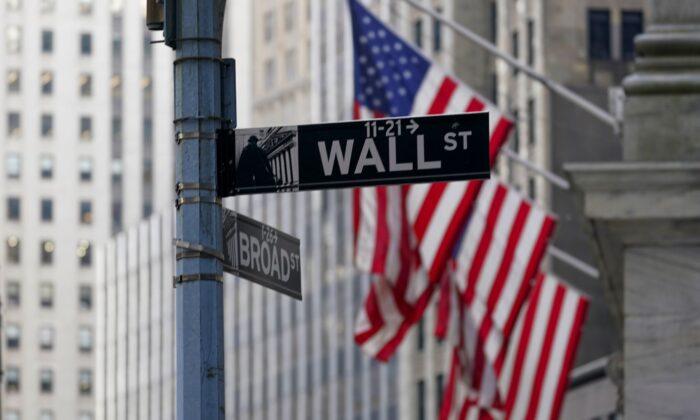NEW YORK—The Dow Jones Industrial Average surged more than 900 points and the S&P 500 had its biggest gain in two years Wednesday after Federal Reserve Chair Jerome Powell downplayed the likelihood of an even larger interest rate hike after announcing the sharpest rate increase since 2000.
The remarks, which came after the Fed announced its decision to raise its key interest rate by double the usual amount, allayed concerns that the central bank was on its way to a massive increase of three-quarters of a percentage point at its next meeting in June.
The S&P 500 climbed 3 percent, its best day since May 2020. The benchmark index is now up 4.1 percent this week, which represents roughly half its monthly loss in April. The Dow jumped 2.8 percent and the Nasdaq climbed 3.2 percent. The indexes had all briefly been in the red earlier in the day.
Bond yields fell after the Fed’s announcement. The yield on the 2-year Treasury dropped to 2.64 percent from 2.78 percent late Tuesday, an unusually large move. The yield on the 10-year Treasury, which influences mortgage rates, fell to 2.93 percent from 2.96 percent. It had initially jumped to 3.01 percent until Powell’s remarks during a press conference.
The comments came shortly after the Fed said it raised its benchmark short-term interest rate by a half-percentage point, it’s most aggressive move since 2000, and signaled further large rate hikes ahead. The increase raised the Fed’s key rate to a range of 0.75 percent to 1 percent, the highest point since the pandemic struck two years ago.
The Fed also announced details of how it will start reducing its huge holdings of Treasury debt and mortgage-backed securities, a tool the central bank has used to help keep long-term interest rates low.
The S&P 500 rose 124.69 points to 4,300.17. The Dow climbed 937.27 points to 34,061.06. The Nasdaq gained 401.10 points to 12,964.86.
Smaller company stocks also posted solid gains. The Russell 2000 rose 51.07 points, or 2.7 percent, to 1,949.92.
The latest move by the Fed had been widely expected, with markets steadying this week ahead of the policy update, but Wall Street was concerned the Fed might elect to raise rates by three-quarters of a percentage point in the months ahead.
Powell eased those concerns, saying the central bank is “not actively considering” such an increase.
The VIX, an index that measures how worried investors are about upcoming drops for the S&P 500, fell about 11 percent, one of its biggest drops this year, after Powell’s remarks.
Earlier, Powell also said the economy can make it through rate increases without falling into a recession.
“The economy is strong and well positioned to handle tighter monetary policy,” he said, though he cautioned “it’s not going to be easy.”
Investors are worrying about whether the Fed can pull off the delicate dance to slow the economy enough to halt high inflation but not so much as to cause a downturn. Still, the market cheered the Fed’s latest moves.
“It’s certainly heady days when the market doesn’t blink at the most aggressive rate hike in 22 years, but keep in mind this was extremely well-telegraphed and priced in,” said Mike Loewengart, managing director, investment strategy at E-TRADE from Morgan Stanley.
The central bank also announced that it will start reducing its huge $9 trillion balance sheet, which consists mainly of Treasury and mortgage bonds, starting June 1.
The market’s gains were widespread Wednesday. Roughly 85 percent of the stocks in the S&P 500 notched gains, with technology companies powering much of the advance. Apple rose 4.1 percent.
Energy stocks were among the biggest gainers following a 5.3 percent increase in the price of U.S. crude oil after Europe took a step closer to placing an embargo on Russian oil as that country continues its war against Ukraine. Any embargo could strain oil supplies and push prices still higher. Exxon Mobil rose 4 percent.
The Fed’s aggressive shift to raise interest rates comes as rising inflation puts more pressure on businesses and consumers. Higher costs for energy and other commodities have prompted many businesses to raise prices and issue cautious forecasts to their investors. Wall Street and economists are worried that higher prices on everything from food to gas and clothing will prompt a slowdown in consumer spending and crimp economic growth.
The worries have worsened with Russia’s invasion of Ukraine and its impact on energy and key food commodity prices. China’s increasingly stricter lockdown measures because of rising COVID-19 cases have also added concerns about slower economic growth because of supply problems and shipping backlogs.
Wall Street is closely watching economic data for any signs that inflation might be easing. Consumer prices surged in March, but a measure of inflation that excludes food and energy had its smallest monthly rise since September. That was a welcome sign for investors and more of the same in the coming months cold temper inflation concerns.
“If we can get just a few more readings showing inflation slowing, that could be the match that sparks some confidence,” said Ryan Detrick, chief market strategist for LPL Financial.





